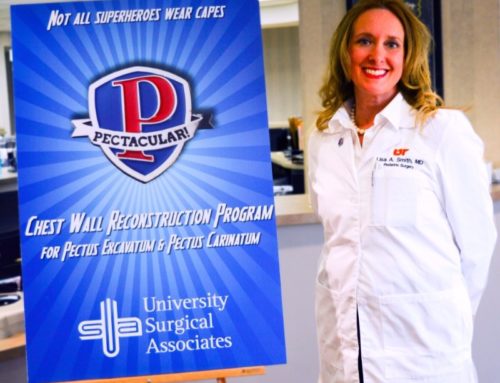
From smart TVs to drones, technology continues to revolutionize the way we live. The medical community is often on the forefront of using technology to improve care. One such instance is robotic surgery. While the name may conjure images of shiny, silver robots with scalpels, this type of surgery is actually performed by highly trained human surgeons, not machines.The term “robotic-assisted surgery” is preferred by doctors since it more accurately portrays what’s happening in the operating room. The surgeons with UniversitySurgical Associates offers robotic-assisted surgery as another innovative tool for quality patient care.
“Robotic-assisted surgery is another minimally invasive approach that we use,” says Dr. Benjamin Dart, general surgeon with University Surgical Associates (USA). Minimally invasive simply means that procedures are performed through small incisions instead of one large opening. “Because the incisions are small,” he says, “patients tend to recover more quickly and experience less pain than with traditional, open surgery.”
Many patients are familiar with robotic surgery used in prostate and gynecologic surgeries but they may not be aware it’s available for general and colorectal procedures as well. “We’ve been using the robotic system with substantial success for inguinal hernia repair,” adds Dr. Dart.
How does it work?
“Robotic surgery is an advancement over laparoscopic surgery because the robotic instruments have a range of motion that exceeds that of the human wrist,” says Dr. Jacob Dowden, general and hepatobiliary surgeon with USA. As in laparoscopic surgery, small incisions are used for entry of surgical instruments from outside the body. The robotic system is then attached to the instruments, and the surgeon controls them from a console in the operating room a few feet away from the patient. “The surgeon fully controls the instruments just as in open or laparoscopic surgery,” adds Dr. Dowden, “The robotic system does not act on its own.”
High definition 3-D cameras are used to create highly magnified images, so your surgeon has a close-up view of the area he or she is operating on. At the ends of the instruments are mechanical wrists that bend and rotate to mimic the movements of the human wrist allowing the surgeon to make small, precise movements inside the body. “The visualization is exceptionally clear,” mentions Dr. Dart, “and the small instruments allow us to perform intricate movements in tight spaces.”
Not just for adults
USA surgeon Dr. Curt Koontz is just one of three pediatric general surgeons in the entire southeast performing robotic-assisted surgery. “While I’ve been using minimally invasive techniques for years, the robotic system offers a better range of motion for certain surgical procedures in pediatric patients,” says Dr. Koontz who believes the technology greatly impacts our region for the better. “Parents don’t have to leave this community to get highly advanced surgical care for their children. It’s right here in Chattanooga.”
Is it right for me?
Robotic-assisted surgery is suitable for many types of procedures, but not all of them. It’s important to discuss options with your surgeon to determine which method is right for you. “We take pride in remaining at the forefront of emerging surgical technologies to provide the widest range of options for our patients,” says Dr. Dart. “Our goal is to help people recover quickly and get back to living their lives faster than ever before. Robotic-assisted surgery means USA surgeons have another tool to address every surgical need with a specific and tailored treatment plan.”
For more informationor to schedule an appointment, call (423) 267-0466. Click here for the robotic surgery webpage.
Pictured above: Dr. Curt Koontz, pediatric surgeon







Leave A Comment